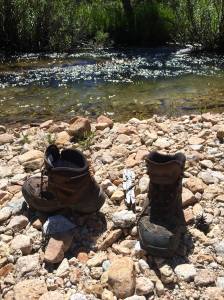“Hiking is the best workout!… You
can hike for three hours and not
even realize you’re working out.
And, hiking alone lets me have
some time to myself.” J.L.
During my last backpacking trip through the Rae Lakes Loop near Fresno, CA, I realized it was time for new boots. Of course I realized it at the end of my hike as I started slip-sliding my way down all the switchbacks and 5000 feet of elevation loss during my last 16 mile day. I was not happy, to say the least! Especially, since at one point I saw bear scat on the trail, no grip to say the least and still a lot of switchbacks and elevation loss to go. . Thankfully, I made it with no bear confrontations!
I decided to finally go and get some new boots yesterday. After listening to all the customer questions circling around me in the store, so here’s my two cents on the subject of buying hiking boots!
Hiking Boots are Called Hiking Boots for a Reason
Choosing the right hiking boots is a not easy and, in fact, may take several tries to make the right choice.
Here’s the deal… Quality hiking boots, or trail runners, are one of the best things you can add to your gear list for hiking and frankly they are also your best investment for hiking. Your dream hiking boots will:
1. Comfortably fit your feet. Making sure a good fit is definitely the key part of the boot-selection process. You must count on your feet when hiking and so why not make them happy! Happy feet equals Happy Hikers and it all starts with a proper fit!
2. Match your hiking goals. For example, huge heavy backpacking boots are not really necessary if all you do are day hikes—unless of course you find you need that extra ankle/foot support to provide you the most amount of comfort!
A good quality pair of hiking shoes will help with many things … like keeping your feet warm, taking away moisture from your feet and will frankly, make your hiking experience much better because your feet are Happy, after all, you are on your feet the whole time.
So here are the basics:
The most important feature is a good fit. Don’t buy a boot because it is the “most expensive” or “best boot” around. Remember, you did not vote for that “Best Boot Around” category. So where do you start? Well, look at your hiking goals. If you are doing day hike with light loads maybe go for a lighter hiking shoe. If you will be backpacking carrying heavy loads, go for a heavier boot. If you need more ankle support then maybe a trail runner is not for you. Here’s a good suggestion … always try on boots at the end of the day. Your feet will swell normally during your day and will be at their largest. This will help you avoid buying boots that are way too small.
So after you decide what type of shoe you need then start by trying on several different pairs.
Here are the things to remember and really what you should be looking for: your heel should be locked in place to avoid friction and blisters (the number one cause of blisters by the way); you should have enough room to wiggle your toes freely so when your feet swell (and oh will they swell!) your shoes are not too tight (I for one always get my shoes a ½ to one full size bigger than I normally wear), and, your toes should not be hitting the front of the boot while going downhill. A store clerk that is knowledgeable in hiking shoes and the inventory, will most likely have a big plastic rock that you can try this out on.
Ok, after you have the fit down, then you can move on to the material part of a hiking shoe.
If you are looking for a water resistance boot for extended trips carrying big loads, you might want to go for full leather. But if you are looking for a lighter weight, which will break in more quickly and thatwill dry faster, go for the synthetic boot. Personally. I try to stay away from the “waterproof” boot as they reduce the breathability and cause my feet to sweat a lot.
SO … there you have it … a little help on buying some hiking boots/shoes. Take my advice and go to REI or someplace similar that has a 100% return guarantee so that if your first pair does not work out, you can return them, no questions asked. I do promise though after you’ve hiked 300-400 miles, looking for that new pair will be so easy with all the knowledge you now have!!
Peace, Love and Nature
Wendy
Your local Hiking Hippie, Life Coaching #1 Fan!
p.s. bring your hiking socks with you when trying on new hiking boots/shoes. This will help with the fit and feel of the shoes you are trying on.

